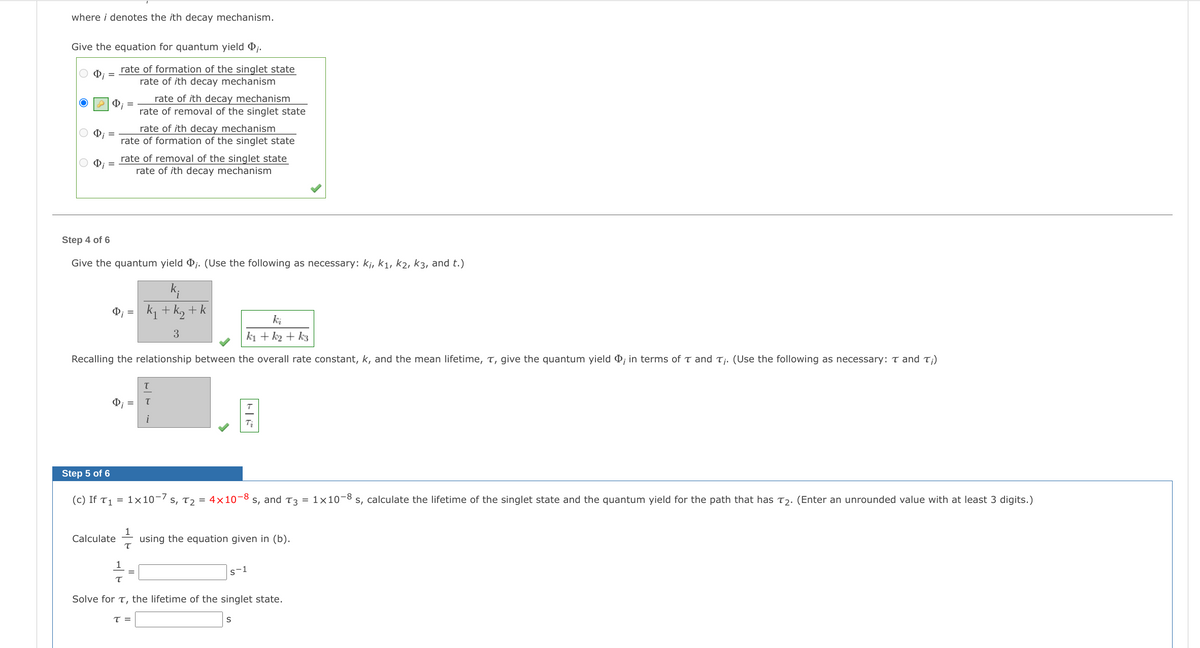(c) If T, = 1x10-7 s, T2 = 4x10-8 s, and T3 = 1x10-8 s, calculate the lifetime of the singlet state and the quantum yield for the path that has T2: (Enter an unrounded value with :least 3 digits.) Calculate using the equation given in (b). s-! Solve for T, the lifetime of the singlet state. T =
(c) If T, = 1x10-7 s, T2 = 4x10-8 s, and T3 = 1x10-8 s, calculate the lifetime of the singlet state and the quantum yield for the path that has T2: (Enter an unrounded value with :least 3 digits.) Calculate using the equation given in (b). s-! Solve for T, the lifetime of the singlet state. T =
Chapter6: Random Errors In Chemical Analysis
Section: Chapter Questions
Problem 6.16QAP
Related questions
Question

Transcribed Image Text:where i denotes the ith decay mechanism.
Give the equation for quantum yield Pj.
rate of formation of the singlet state
rate of ith decay mechanism
rate of ith decay mechanism
rate of removal of the singlet state
2 0; =
rate of ith decay mechanism
rate of formation of the singlet state
rate of removal of the singlet state
rate of ith decay mechanism
O; =
Step 4 of 6
Give the quantum yield Þj. (Use the following as necessary: kj, k1, k2, k3, and t.)
k + k, + k
ki
3
ki + k2 + k3
Recalling the relationship between the overall rate constant, k, and the mean lifetime, T, give the quantum yield P; in terms of t and Tj. (Use the following as necessary: T and T;)
i
Step 5 of 6
(c) If T1 = 1×10-/ s, T2 = 4x10-8 s, and T3 = 1×10-8 s, calculate the lifetime of the singlet state and the quantum yield for the path that has T2. (Enter an unrounded value with at least 3 digits.)
Calculate
using the equation given in (b).
s-1
Solve for T, the lifetime of the singlet state.
T =
Expert Solution
This question has been solved!
Explore an expertly crafted, step-by-step solution for a thorough understanding of key concepts.
This is a popular solution!
Trending now
This is a popular solution!
Step by step
Solved in 3 steps

Knowledge Booster
Learn more about
Need a deep-dive on the concept behind this application? Look no further. Learn more about this topic, chemistry and related others by exploring similar questions and additional content below.Recommended textbooks for you


Principles of Instrumental Analysis
Chemistry
ISBN:
9781305577213
Author:
Douglas A. Skoog, F. James Holler, Stanley R. Crouch
Publisher:
Cengage Learning

Chemistry: The Molecular Science
Chemistry
ISBN:
9781285199047
Author:
John W. Moore, Conrad L. Stanitski
Publisher:
Cengage Learning


Principles of Instrumental Analysis
Chemistry
ISBN:
9781305577213
Author:
Douglas A. Skoog, F. James Holler, Stanley R. Crouch
Publisher:
Cengage Learning

Chemistry: The Molecular Science
Chemistry
ISBN:
9781285199047
Author:
John W. Moore, Conrad L. Stanitski
Publisher:
Cengage Learning

Chemistry: Principles and Reactions
Chemistry
ISBN:
9781305079373
Author:
William L. Masterton, Cecile N. Hurley
Publisher:
Cengage Learning

Introduction to General, Organic and Biochemistry
Chemistry
ISBN:
9781285869759
Author:
Frederick A. Bettelheim, William H. Brown, Mary K. Campbell, Shawn O. Farrell, Omar Torres
Publisher:
Cengage Learning